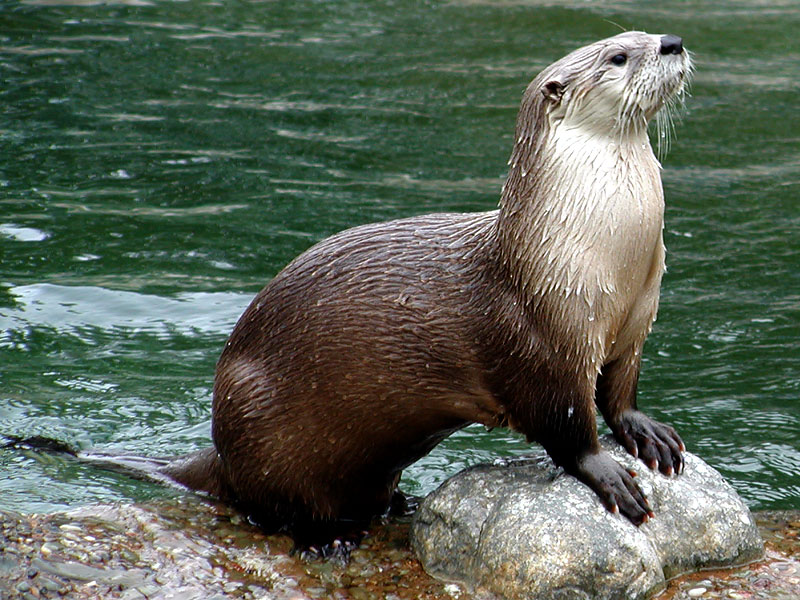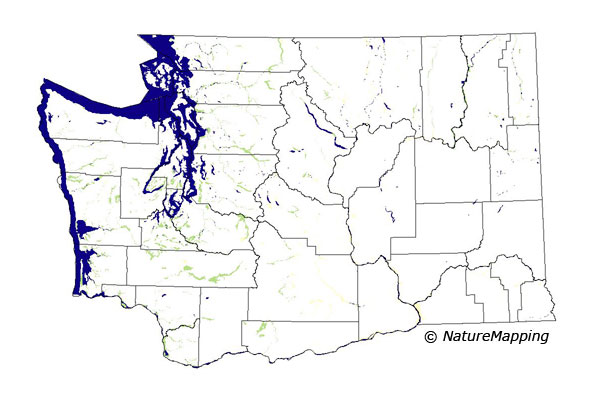
Description
North American River Otters are semi-aquatic mammals. Body is very long, slender, and sleek. Most river otters weigh approximately 20-30 pounds. Body length from head to tail is about two and a half feet, with the tail itself measuring about twenty inches. Head is wide and round with small eyes, small ears. The ears and nostrils of the otter close up when it's underwater. Whiskers are long and thick and very sensitive. Very important for sensory perception underwater. Legs are short but very powerful. All four paws are webbed and have claws. Tail is long and slightly tapered at the end. Musk producing glands are located at the base of the tail. The fur is a dark brown to almost black above while the fur underneath is a much lighter brown to tan. Fur on the throat and cheeks are usually a golden brown. The fur is very dense and soft, very efficient for insulating the animals in the water. Males are bigger than females in all measurements.
Geographic Range and Habitat
The North American River Otter is the most numerous of all the otter species. They range throughout Canada and the United States, avoiding the arid areas of Texas, Nevada, Arizona, and California. Another location they can be found is in the delta areas of the Rio Grande and Colorado River in Mexico. They like to live within about one hundred meters of rivers, lakes, and streams. Also like to live in coastal marine habitats including swamps and marshes. They are able to tolerate a wide variety of climates and environments. River otters can be found where there is a permanent supply of food. If an area becomes polluted, the river otter will leave as it's very sensitive to pollution.
The den of the river otter is usually built and abandoned by another animal, usually along a river bank, or it'll be made from a natural hollow, such as a hollow log. The otter will make one entrance under the water. The tunnel leads up to a chamber that will be set well above water level. This will be where the female otter makes her nest. The nest chamber is usually lined with grass, moss, bark, and leaves. There is another entrance above water as well. This gives the otters two ways to get in and out of the den and it provides good ventilation to the underground chambers of the den.
Behavior and Habits
River otters are probably best known for their sense of fun. While most mammals play and romp while they're young, otters are always looking for things to play with and places to slide even throughout their adult years. Otters belong to the weasel family, but they don't behave anything like their relatives. which include weasels, badgers, skunks, stoats, martens, wolverines, and mink. These are all fierce, aggressive animals. Otters behave just the opposite. Play is very important to these lively animals and they can keep it up for hours. They exhibit behaviors such as mud and snow sliding, burrowing through the snow, and much playfulness in the water. Many of these activities serve a purpose in creating social bonds, in developing hunting techniques, and in scent marking. River otters have a high metabolism that helps them to be the energy fueled animals that they are. This requires them to eat a lot during the day. Usually found alone or in pairs. A basic social group will consist of a mother and her pups with the pups leaving their mother when she gives birth again. Males usually don't associate in groups except during the breeding season.
Lifespan/Longevity
North American river otters normally live 8 to 9 years in the wild. In captivity, they can live as long as 21 years.
Home Ranges
A female otter with pups will have a home range of about 12-30 square miles of waterway. A male otter's range is much bigger, ranging up to 100 square miles. The size of the home range depends on the availability of water and food within that range. The otter will remain within the range year round unless a harsh winter freezes all the water resources within the range. The otter is then forced to leave to find open water. Even with these large ranges, river otters are only slightly territorial and they practice mutual avoidance. Neither a male or a female river otter has a range that'll overlap one of the same sex. A male otter's range will overlap other female otter ranges though. He'll frequently breed with the females living within his range.
Reproduction
North American river otters mate in the spring in the months of March and April, but the fertilized eggs don't develop until much later in the year. Most likely, the eggs develop in December or January. This delay is there because the young are not born until the following spring. The weather needs to be warm enough to be safe for the newborn pups. Actual mating takes place after the female gives birth. The otters copulate in the water where the process takes up to 25 minutes as the male holds onto the female's neck
River otter's are sexually mature at the age of 2 years. Females will breed in their second year, but a male won't breed until about his fifth year since he needs to have an established home range before gaining access to any females to breed with. The female will deposit a scent in different locations in her range, indicating that she is ready to breed. Male otters are able to detect the different scent from others that the female is ready to breed. Courting otters tend to make noises including whistles, chuckles, and bird-like chirps. The otter pair will spend a lot of time nuzzling each other. There is a delay of about 8 to 13 months delay between mating and birth. This is because the fertilized egg within the female doesn't start to grow at first. The egg eventually is implanted in the uterus wall and it begins to grow. A period of about 7 weeks is how long the pregnancy lasts.
Life of a river otter pup
When it's time for the pups to be born, the female will line the dry chamber of her den with grasses and leaves. The birth of the pups usually happens around late March to April. Usually, there are two to three pups born. The pups weigh about 4-8 ounces at birth. They are born blind and toothless, but they have fur, claws, and whiskers. Their eyes don't open till about they're 5 weeks old. The mother otter takes great care of her pups, feeding them and licking them clean. She'll curl her body around them to keep them warm. The young otters grow rapidly from drinking the rich milk from their mother. As the pups grow, the mother otter keeps them isolated in the den. The pups are quite helpless until they are around six weeks old. At this age, the pups begin to tumble and play with their mother and each other. Some playtime activities might include rolling pebbles around and around from paw to paw and a pup might juggle a chunk of food or a piece of wood on the end of its nose. The pups must wait until they are three to four months old before their mother will allow them to do any type of playing outside of the den. Even after taking them outside, the mother otter is very protective of her pups. She'll protect them from any possible danger. The father isn't allowed to come near the pups until they're at least six months old.
Once the young otters have grown their thick adult coats, the mother otter must teach them to swim. Even otters need to be taught how to swim. The pups first like to play in the shallow waters as they splash and chase each other. The mother has to coax them away from this in order to get the pups into deeper water for them to swim in. The pups will have a tendency to resist as they squeal and try to stay on land. The mother otter must grab them by the scruff of their neck and drag them back into the water. She'll sometimes swim with the pups on her back. When she's our far enough, she'll sink and the pup must paddle and thrash to keep itself afloat. The mother is always close by to rescue it if the pup gets into any trouble. Once the young otters lose their fear of the deep water, they soon learn to swim very quickly. Soon they're swimming, diving, chasing, and playing with other otters.
Otter Movement
Even though river otters love to be in, under, and around water, their short legs can carry them very well on land. When they are on land the body is held at an arching position as they run, with their tails held out stiff. The tail is used for balance while on land. The walk is very awkward and almost a run. River otters hump up their backs and straighten their body out again, kind of like an inchworm. The otters get good traction from the four rough bumps on their hind paws. These bumps give them good traction on slippery surfaces. Compared to a deer or bobcat, the river otter is pretty slow, but it can outrun a human. Otters can attain a speed of 18 mph.
In the water river otters are at their best. They have adapted perfectly to the aquatic lifestyle. Being well suited to swim and dive, their slippery hydrodynamic form exemplifies the perfect adaptation to an amphibious way of life. Otters have webbed paws, with small dexterous front paws and large, powerful hind paws. The muscular tail is thick and flat at the base, tapering to a point. Otters use their hind limbs and undulating movement of their tail as the main source of propulsion through water, but they may also use their forelimbs for paddling. Otters have excellent vision, especially when they're under water. This helps them in catching prey. Stiff whiskers, which are sensitive to water turbulence, are another adaptation to finding prey in muddy or dark waters. The thumbs on the front paws show freedom of movement, and can be opposed when picking up, holding small objects or assisting in eating their prey. Sometimes, river otters will swim together in a circle, creating a whirlpool in the water. This brings up any bottom dwelling fish for them to eat.
Washington River Otter Breeding Range
